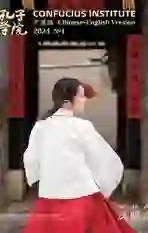博山琉璃:一炉窑火映千年 Boshan Coloured Glaze: A Thousand Years of Art in Furnace Flame
2024-03-04李福源LiFuyuan
李福源 Li Fuyuan
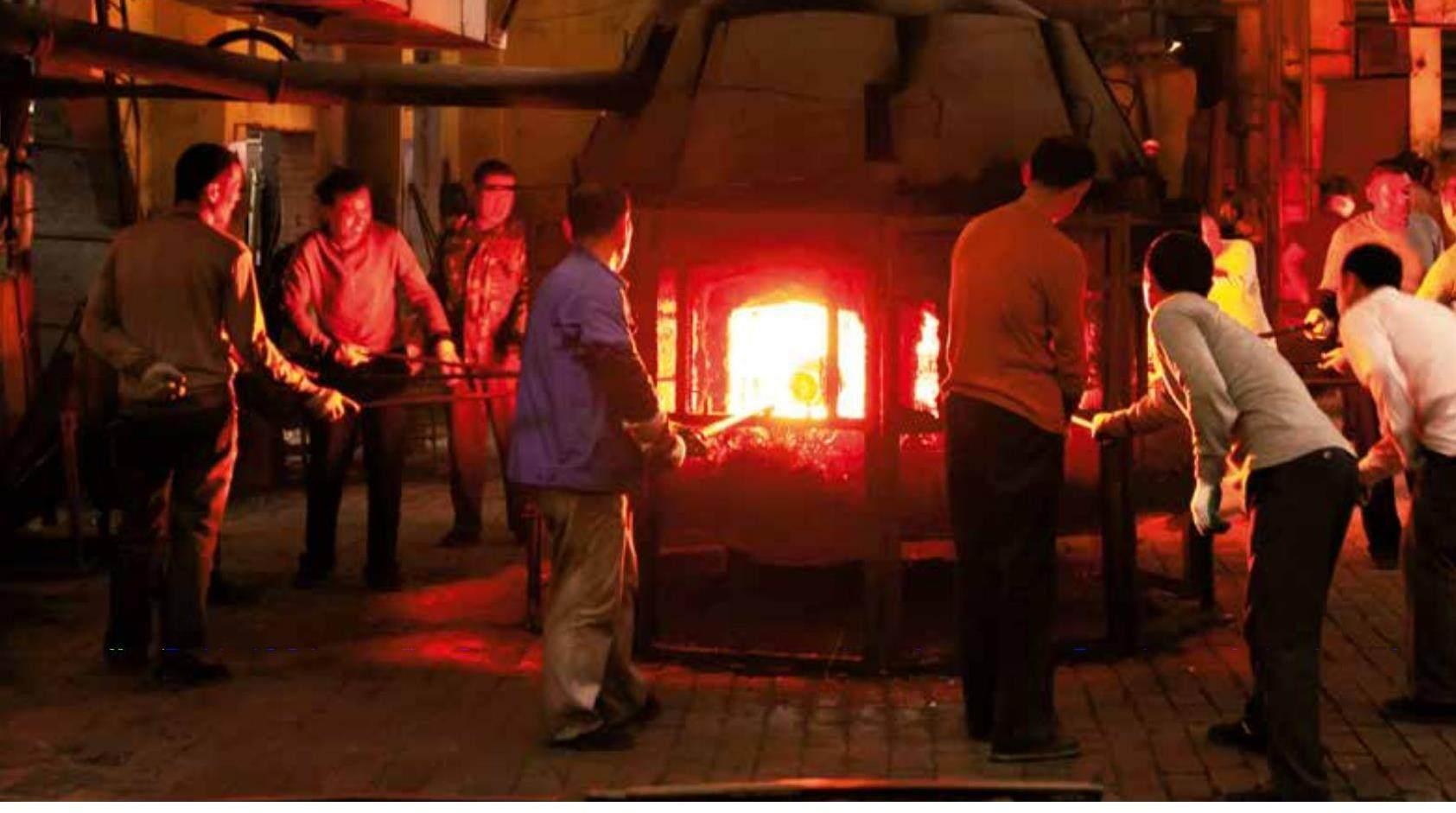
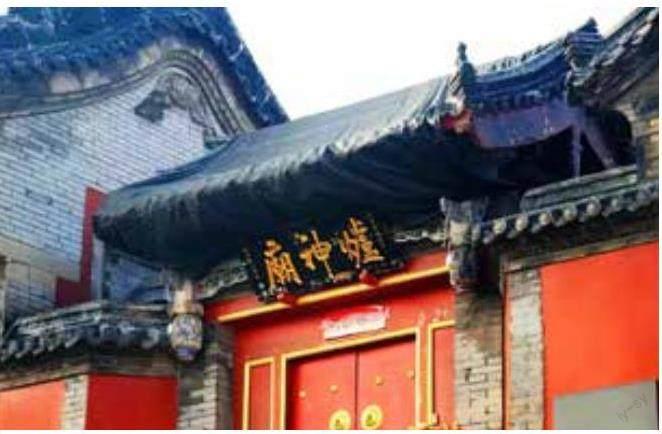


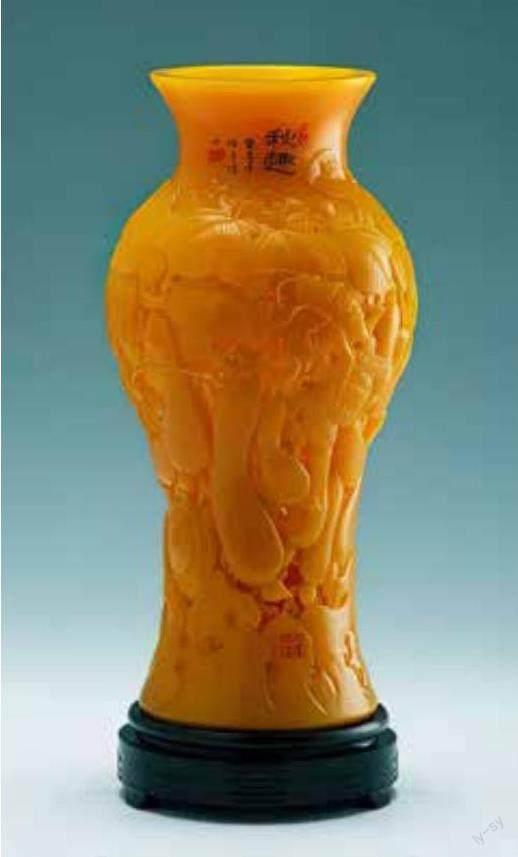
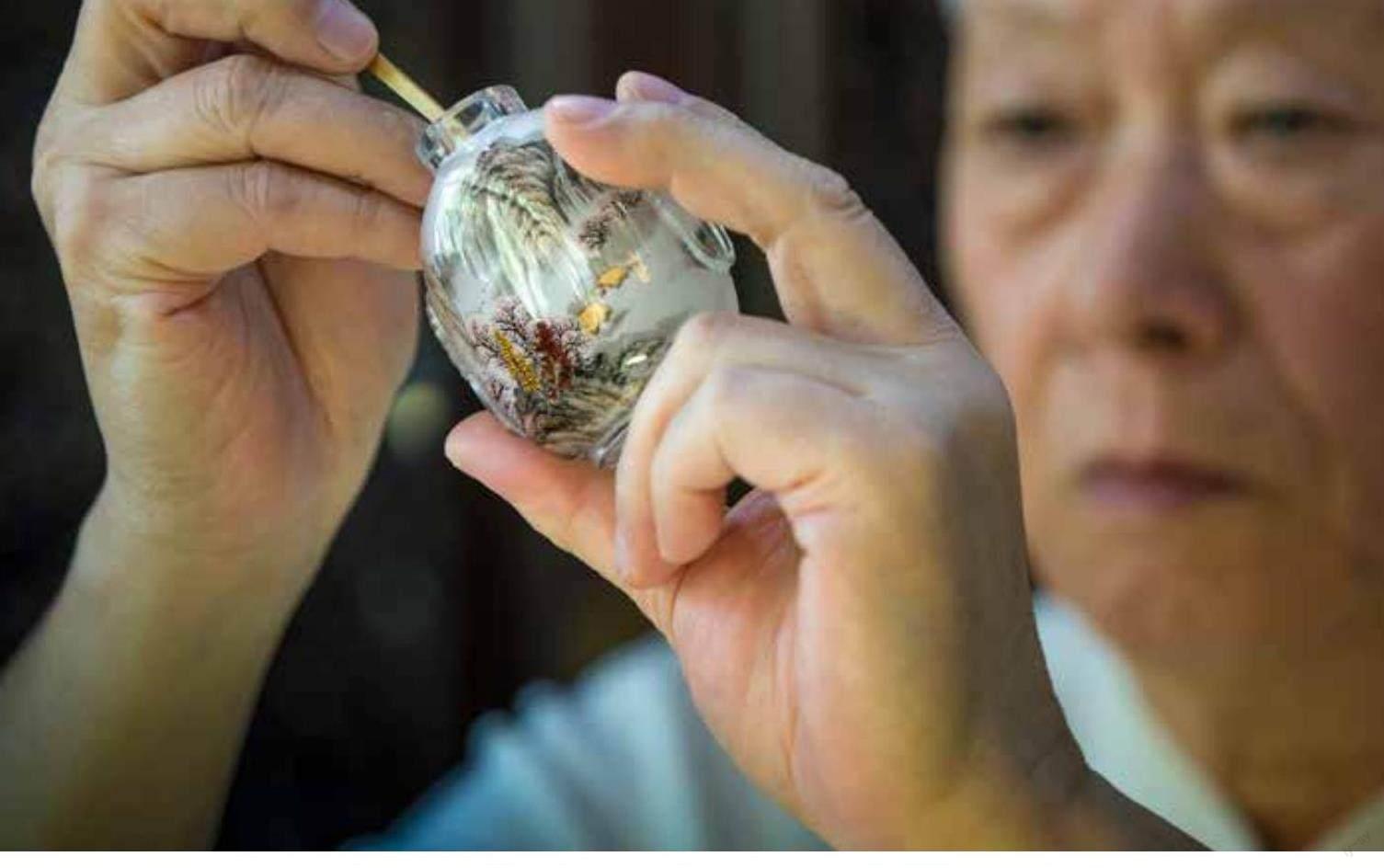
琉璃之于博山,正如陶瓷之于中国。
Coloured glaze is to Boshan what ceramics are to China.
淄博市博山區是著名的中国琉璃之乡,博山琉璃历史悠久、种类繁多、工艺精绝,在历史上曾长期引领中国琉璃发展的主方向,具有浓厚的艺术文化气息,是我国宝贵的艺术遗存。Boshan District in the city of Zibo is renowned as the hometown of coloured glaze inChina. Boshan coloured glaze boasts a long history, diverse types, and exquisite craftsmanship.It has played a leading role in the development of Chinese coloured glaze with rich aestheticand cultural taste, thus a precious artistic heritage of China.
20世纪80年代,博山挖掘出了中国现存最早的古琉璃窑炉遗址—元末明初琉璃作坊遗址。这个作坊遗址规模庞大,出土器物在器型及技术手段上都极为成熟,专家们推断,博山琉璃的起源或应更早,但现在通常把博山琉璃的起源定为元末明初时期。这里还诞生了中国最早也是唯一的炉神庙,著就了中国古代第一部琉璃专著《琉璃志》,建成了中国第一家琉璃博物馆。
In the 1980s, Boshan unearthed the earliestsurviving ancient furnace site — a coloured glazeworkshop dating back to the late Yuan and earlyMing dynasties. The scale of this workshop site wasenormous, and the unearthed artifacts were highlysophisticated in both form and technique. Expertsspeculate that the origin of Boshan coloured glazemight be even earlier, but it is generally recognizedto have originated in the late Yuan and early Mingperiods. This region also gave birth to China’s firstand only Furnace God Temple, authored the firstmonograph on coloured glaze in ancient Chinatitled “Records of Coloured Glaze,” and establishedChina’s first coloured glaze museum.
明洪武初年,宫廷内官监在博山设立专制“贡品”的琉璃作坊,由当地孙氏家族牵头,造珠灯、珠帘,供用内廷。此后,孙氏家族作为在籍的宫廷匠役,为明宫廷提供琉璃贡品长达275 年。
In the early years of Hongwu reign in the MingDynasty, led by the Suns, a local family, an exclusivecoloured glaze workshop was set up in Boshan toproduce coloured glaze articles of daily use suchas lamps and curtains for the imperial court. As court craftsmen, the Sun familysupplied coloured glaze offeringsto the Ming court for 275 years.
同一时期,博山蒋氏、钱氏及其他家族纷纷涉足琉璃行业,他们或以生产为主,或以销售为主,将博山琉璃推向全国。明嘉靖《青州府志》评价博山琉璃说:“琉璃器出颜神镇(博山区前身)……以土产马牙、紫石为主,法用黄丹、白铅、铜绿焦煎成之。珠穿灯、屏、棋局、帐钩、枕顶类,光润可爱。”明朝中叶,博山琉璃业已极为繁盛,城镇居民几乎家家制作琉璃。清康熙《益都县志》记载:“(琉璃)颜神镇居民独擅其能,镇土瘠确而民无冻馁者以此。”博山也因此成为全国最大的琉璃生产、销售基地,被科技史学界称为“明清时代琉璃制造中心”。
During the same period,other families such as the Jiangsand Qians in B oshan alsoentered the industry. They wereinvolved in production or sales,promoting Boshan colouredglaze nationwide. The during theJiajing reign of mid-Ming praisedBoshan coloured glaze, stating,“Yanshen Town (former nameof Boshan) is famous for itscoloured glaze. Locally producedcalcite and purple stone areused as the main materials,combined with yellow cinnabar,white lead, and verdigris. Theproducts include various itemssuch as bead-threaded lamps,screens, chess sets, curtainhooks, and pillow ornaments,all shiny and lovely.” By the mid-Ming Dynasty, the coloured glaze industry in Boshan hadbecome quite prosperous, withalmost every household in thetown involved in production.In the written during the Kangxireign of the Qing Dynasty,it is recorded: “Residents ofYanshen Town excel in makingcoloured glaze, and the town’sland is barren yet the peopledo not suffer from coldness orhunger thanks to the industry.”Consequently, Boshan becamethe largest production andsales base for coloured glazein China, earning recognitionfrom scholars in the historyof science and technologya s the “Col oured Gl a z eManufacturing Center of theMing and Qing Dynasties.”
清康熙三十五年(1696年),宮廷造办处分设玻璃厂,主要生产玻璃鼻烟壶、瓶、碗等器物。起初,玻璃厂中的工匠都由西洋人充任。后来,除少数外国人外,工匠主要从博山征调,所用琉璃料条等也大都产自博山。博山的琉璃炉被誉为“御炉”,博山的工匠则被称为“御匠”。
In the 35th year of theKangxi reign (1696) of theQing Dynasty, the imperialhousehold office establisheda glass factory in Boshan,primarily producing glasssnuff bottles, bottles, bowls,and other items. Initially,craftsmen in the factory weremostly Westerners, but later,apart from a few foreigners,most craftsmen were recruitedlocally from Boshan, and theglass materials used were mostly from Boshan. Boshan’s glass furnaces werepraised as “Imperial Furnaces,” and its craftsmen“Imperial Craftsmen.”
自清嘉庆时期起,国力衰退,全国琉璃制作技艺整体下滑,博山琉璃迎合时尚变化和市场导向,呈现出一枝独秀的局面。19世纪,博山琉璃业空前繁荣,经营范围扩大,器物类型多样,鼻烟壶、烟嘴、仿制玉饰等屡有创新。同治年间,英国传教士威廉姆森到博山考察琉璃产业,记载了当时琉璃生产的盛况:“只见博山上空笼罩在一片烟雾之中,人们都在为制造玻璃而紧张地忙碌着。当时不分老幼,约有7/10的男女都在从事玻璃制造,每年向外输出70多万斤玻璃制品……”并且,他评价说:“数千年来,擅长制造瓷器的中华民族,在玻璃制造这一行业方面,是显著地、远远地落后于欧洲。但是,博山这个地方却做出了值得世界认可的成就。”
Starting from the Jiaqing reign of the QingDynasty, as the national strength declined, the overallskills in coloured glaze making declined. Boshancoloured glaze, however, adapted to fashion changesand market trends, presenting itself as a standout.In 19th century, Boshan coloured glaze industry tothrive unprecedentedly, with an expanded range ofinnovative products such as snuff bottles, tobaccopipes, and imitations of jade ornaments. Duringthe Tongzhi reign, British missionary Williamsonvisited Boshan to study the industry and recordedthe prosperity of coloured glaze production at thattime: “The sky over Boshan is covered in smoke, withpeople busy making glass. At that time, regardlessof age, about 7/10 of men and women were engagedin glass manufacturing, shipping more than 770,000pounds of glass products all over the countryannually.” He also commented, “For thousands ofyears, the Chinese, who excel in making ceramics,have been significantly far behind Europe in the glassindustry. However, Boshan has made achievementsworthy of world recognition.”
博山琉璃最初的销售方式主要是集市贸易和长途贩运。后来,随着生产日益发展,出现了专门销售博山琉璃的商店——料货庄,其销售范围更加广阔。史料记载,清朝至民国时期,博山曾先后在全国各地设立100 多个料货庄,这些料货庄呈网状分布,以博山为中心,辐射全国,真正实现了“琉”通天下。
At first, Boshan coloured glaze were mainlysold in the local market or out of town by longdistancetransportation. Later, with the increasingdevelopment of production, specialized stores knownas “Liaohuozhuang” emerged, providing a widerrange of products. Historical records show thatfrom the Qing Dynasty to the Republic of Chinaera, Boshan successively established more than 100Liaohuozhuang stores across the country, forminga nationwide network centered on Boshan, truly“uniting the world through coloured glaze.”
中華人民共和国成立后,博山琉璃业也迎来了快速发展的春天。原有的琉璃作坊经过改组合并,一跃成为国营工厂,生产设备、制作工艺不断升级,产品研发不断拓展,以博山美术琉璃厂为代表的大型琉璃企业应运而生,并发展成为全国琉璃业的翘楚。经过半个多世纪的积淀、研发,截至目前,博山琉璃产品已形成几十个门类、上千种类型、近万种花色,代表性作品有琉璃花球、花插、摆件等,其中最为世人熟悉和认同的,当属琉璃内画和名贵料器“鸡油黄”。
After the founding of the People’s Republic ofChina in 1949, the Boshan coloured glaze industryushered in a period of rapid development. Traditionalworkshops were reorganized and merged into stateownedfactories. With continuously upgradedproduction equipment, manufacturing techniquesand product design, large glaze enterprises,represented by the Boshan Fine Glaze Factory,emerged as the national leaders in the industry.After more than half a century of research anddevelopment, as of now, Boshan glaze products have formed a sophisticated system featuring dozensof categories, thousands of types, and nearly tenthousand colors. Representative works include flowerballs, vases, and ornaments, among which the mostwell-known and recognized are the inside-paintedglaze and the precious “Chicken Oil Yellow.”
博山琉璃内画技艺传自北京。清道光年间,博山商人王凤诰从北京周乐元处学得内画技艺后,传于毕荣九,毕荣九在反复研习后,终于掌握了内画技艺的奥妙。此后,毕荣九将全部精力投入到内画创作和传承中,他用20余年的时间创作了大量内画作品,并培养了一批内画艺人。他们技法纯熟,风格独特,形成了内画艺坛上的独立画派,被艺术界称为“鲁派内画”,与“京派内画”齐名。时至今日,内画技艺在博山已传承130余年,鲁派内画也作为博山琉璃的代表性产品饮誉海内外。
The technique of insidepaintedglaze in B oshanor iginated f rom Be ij i ng.During the reign of EmperorDa o g u ang i n t he Q i n gDynasty, Boshan businessmanWang Fenggao learned thetechnique of inside paintingfrom Zhou Leyuan in Beijing,and passed it on to Bi Rongjiu.After assiduous practice, Bifinally mastered the intricaciesof the technique. Later on,Bi devoted all his energy toinside painting creation andinheritance. In over 20 years,he created a large numberof inside-painted works andtrained a group of artists. Theirskilled techniques and uniquestyle formed an independentschool known as the “Lu (shortname for Shandong) School of Inside Painting,”which was considered as equal to the “Beijing Schoolof Inside Painting.” Today, the technique in Boshanhas been around for more than 130 years, and theinside-painted glaze of Lu School , as a representativeproduct of Boshan coloured glaze, is renowned bothat home and abroad.
博山名贵料器“鸡油黄”兴起于明初,盛产于清乾隆年间,因其雍容华贵,被尊称为“御黄”“黄玉”。鸡油黄的特点是“润如玉,凝如脂,声如磬,价如金”,因制作门槛高、难度大,历来为皇室和宫廷专用,民间严禁生产。鸡油黄的制作工艺曾一度失传,直到1972年,博山美术琉璃厂经过反复试验,终于使之重现于世。此后,博山琉璃工匠不断改良,如今的鸡油黄琉璃作品,经故宫博物院专家评定,其创作水平已经超越了乾隆时期的同类作品。
The precious glaze “Chicken Oil Yellow” inBoshan rose to prominence in the early MingDynasty and flourished during the Qianlong reignof the Qing Dynasty. Knownfor its elegant and gorgeouscolour, it is also referred to as“Imperial Yellow” or “YellowJade.” The characteristicsof Chicken Oil Yellow aredescribed as “smooth as jade,exquisite as cream, soundlike a chime, and valuable asgold.” It has always been forimperial and court use onlydue to its complicated anddifficult production process,strictly prohibited for civilianproduction. The craftsmanshipof Chicken Oil Yellow wasonce lost but was final lyrediscovered by the BoshanFine Glaze Factory in 1972after repeated experiments.Since then, Boshan glazecraftsmen have continuouslyimproved it. Today’s ChickenOil Yel l ow glaze wor k s ,evaluated by experts from thePalace Museum, have surpassed similar works fromthe Qianlong period.
在市场化浪潮的席卷之下,也涌现了一批个体琉璃工匠,他们不仅传承了博山琉璃的技术和工艺,还以更宽阔的视野,将博山琉璃推向世界。目前,博山区有六位艺术大师分别荣获“中国石榴王(琉璃)”“中国孙氏琉璃鸡油黄”“中国琉璃葡萄孙”“中国琉璃内画张”“中国张氏琉璃鸡肝石”“中国琉璃葫芦孙”等国家级荣誉称号。此外,这里还有国家级琉璃艺术大师42名、省级大师123人,琉璃生产企业20余家、专业博物馆及艺术工作室50余个,琉璃产业直接从业人员5 000余人,为博山琉璃的后续发展打下了厚实的基础,博山也因此赢得了“世界琉璃看中国,中国琉璃看博山”的美誉。
Against the tidal wave of marketization, agroup of individual coloured glaze craftsmenhave also emerged. With traditional techniquesand craftsmanship and a broader vision, they arepromoting Boshan glaze to the world. Currently,Boshan District has six art masters who haverespectively been honored with national titles,namely, “China Pomegranate King (Glaze),” “ChinaChicken Oil Yellow Glaze of Sun Family,” “ChinaGlaze Grape of Sun,” “China Inside-painted Glazeof Zhang,” “China Pheasant Liver Stone Glaze ofZhang Family,” and “China Glaze Gourd of Sun.” Inaddition, there are 42 national-level glaze art masters,123 provincial-level masters, more than 20 glazeproduction enterprises, and over 50 glaze museumsand art studios. The industry directly employs morethan 5,000 people, laying a solid foundation for thefuture development of Boshan coloured glaze. As aresult, Boshan has earned the reputation of “FinestColoured Glaze in China and the World.”
今天,博山琉璃以其特有的文化內涵和艺术底蕴延绵传承,焕发出独特而巨大的魅力,在世界民族文化艺术之林里大放异彩。
Today, Boshan coloured glaze, with its uniquecultural significance and artistic depth, continues tothrive and shine brightly in the world of culture andarts.
供图/ 苏鹏 张健 山东画报图片库
猜你喜欢
杂志排行
孔子学院的其它文章
- “ 四廊一线”游山东 “ Four Corridors and One Route for Cultural Experience” in Shandong Province
- 山东青州龙兴寺遗址出土窖藏佛教造像赏析 Buddhist Sculptures from Longxing Temple in Qingzhou
- 潍坊风筝:放飞想象 Weifang Kites: Setting Imagination Alight
- 青岛的啤酒文化 The Beer Culture of Qingdao
- 美国中文教师谈本土教师的培养与培训 Chinese Language Educators on the Cultivation and Training of Local Teachers in the United States
- 二十四节气之立秋和处暑 The 24 Solar Terms
